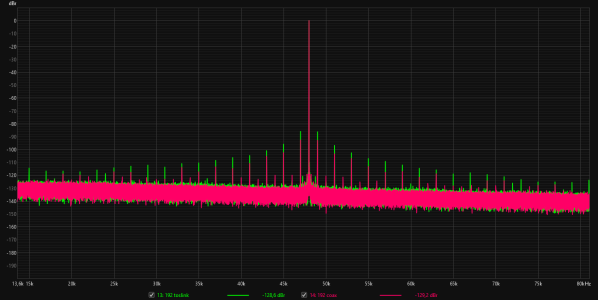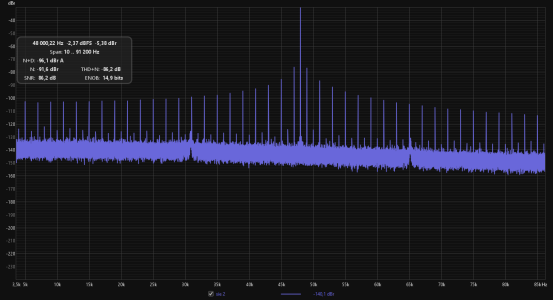Well, let’s just say this is rather academicalI am afraid I don’t understand what you are saying…
Can you please explain it to an eight years old child?
You are using an out of date browser. It may not display this or other websites correctly.
You should upgrade or use an alternative browser.
You should upgrade or use an alternative browser.
Jitter over digital outputs for different WiiMs
- Thread starter onlyoneme
- Start date
What affect more of the sound jitter or sinad? Sorry for a silly question.Well, let’s just say this is rather academicaland was more or less addressed to OP. But take a look at the first pics in the thread 'My Ultra tests' . The digital output signal graphs (measured with a scope) look much more accurate for Ultra, but once you measure actual jitter spectrum of the analog signal reproduced by this specific DAC there seems to be no visible improvement compared to Pro.
If talking just about numbers - no, it does not outperform current top end DACs. It never did.You have rme dac right? Is the dac you have has better measurements than any current line offer by topping/smsl? From what other reviewer saying despite its outdated chipset it outperforms the top end topping/smsl?
One remark, this eye pattern was made for highest bandwidth 192 kHz test signal. Tests above are for 48 kHz. test signal.Another interesting observation is that a significantly more accurate SPDIF eye pattern with Ultra vs Pro does not translate into a significantly better jitter spectrum in this setup
Fantastic work, as ever. Thank you very much for your invaluable contributions to this forum @onlyoneme
He’s understanding in audio is top notch. We learn many things from him.Fantastic work, as ever. Thank you very much for your invaluable contributions to this forum @onlyoneme
Really nice words, thank you, but far from the reality. There is a lot of things in audio which are unknown for me and my knowledge has huge limitations.He’s understanding in audio is top notch. We learn many things from him.
It is not silly and I cannot give you a quick answer.What affect more of the sound jitter or sinad? Sorry for a silly question.
It depends on the result levels. Harmonics propagation can be much more important than the THD result. There are very limited studies on the jitter audibility.
I tried changing PLL and there were some noticeable differences. On the lowest setting the sound become diffuse hard to distinguish each musical note but provide big soundstage and high setting sound was crystal clear like musician is right infront of you. Maybe some call it forward sound. I left it on default middle setting.It is not silly and I cannot give you a quick answer.
It depends on the result levels. Harmonics propagation can be much more important than the THD result. There are very limited studies on the jitter audibility.
There is a lot of possibly interesting test cases, like different cables at high freq sample rates, different PSUs, also different test signals. I will record a music sample from the Mini with PLL on and off, for an audibility test.
Om the Pro it seems that coax is a bit better than toslink on 24/192, but at 24/48 the toslink is slightly better than coax. Does that make sense?Let's talk about the jitter over digital outputs. I will use the Holo Audio Spring 3 DAC which is a true NOS DAC and has an unique ability to turn off its PLL. This way I can compare a raw performance of the outputs in j-test.
Ultra, toslink:
View attachment 9690
Ultra, coaxial:
View attachment 9691
Pro, toslink:
View attachment 9692
Pro, coaxial:
View attachment 9693
Mini, toslink:
View attachment 9694
Non-WiiM device for a quick comparison, SMSL PO100 Pro, coaxial:
View attachment 9696
All WiiMs have similar random jitter level, which is reflected by the noise floor, but they differ a lot with the periodic jitter, which is visible as symmetric spikes around the fundamental signal.
A disclaimer, as I didn't mention it yet - all these tests were made with 48 kHz test signal, which is commonly used for jitter measurements. Results may differ for higher sample rates which may be more problematic for toslink cables, especially lower quality ones.
For example, 192 kHz test case on the Pro, toslink vs coaxial:
View attachment 9700
Another example, 192 kHz again but the Pro vs the Ultra, both on coaxial outputs:
View attachment 9702
Pro, toslink vs coax - 24/192

Pro, toslink - 24/48

Pro, coax - 24/48

In any way these are measurements are so good/low that it will be impossible to tell them apart when listening to music after the DAC has done it job
Yes. I've used a random, really cheap toslink cable which can affect results at high sample rates.Om the Pro it seems that coax is a bit better than toslink on 24/192, but at 24/48 the toslink is slightly better than coax. Does that make sense?
Matias
Member
Can you also please show a worst case, Mini at 192 kHz, with PLL turned on, just to check how much the DAC deals with it?
a hdg dac making an effort in subjective but also important in "objective-technical"Can you also please show a worst case, Mini at 192 kHz, with PLL turned on, just to check how much the DAC deals with it?
very far from the positioning of a mini ;-))) very very....
Matias
Member
@onlyoneme if not asking too much again, I always wondered how jitter is shown in a 32 multitone test. Can you also do with and without PLL too?
alpha_zulu
Senior Member
A bit about jitter and whether we should be afraid of it. I think the video is quite factual, but I don't know if everything is true. There are probably different opinions on this.
If it’s audible to human hearing then it’s a problem.A bit about jitter and whether we should be afraid of it. I think the video is quite factual, but I don't know if everything is true. There are probably different opinions on this.
Similar threads
- Question
- Replies
- 47
- Views
- 3K
- Replies
- 3
- Views
- 1K
- Question
- Replies
- 10
- Views
- 1K
- Replies
- 11
- Views
- 477
- Replies
- 14
- Views
- 2K
D


